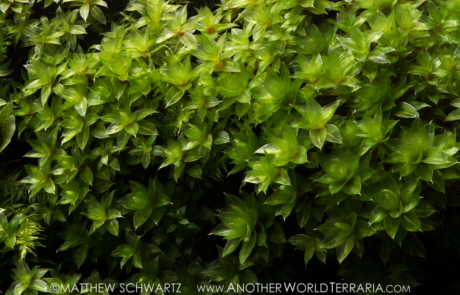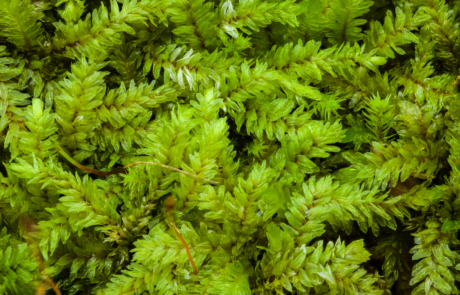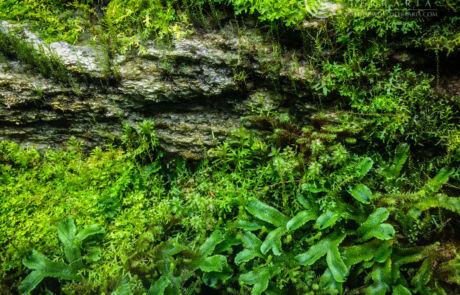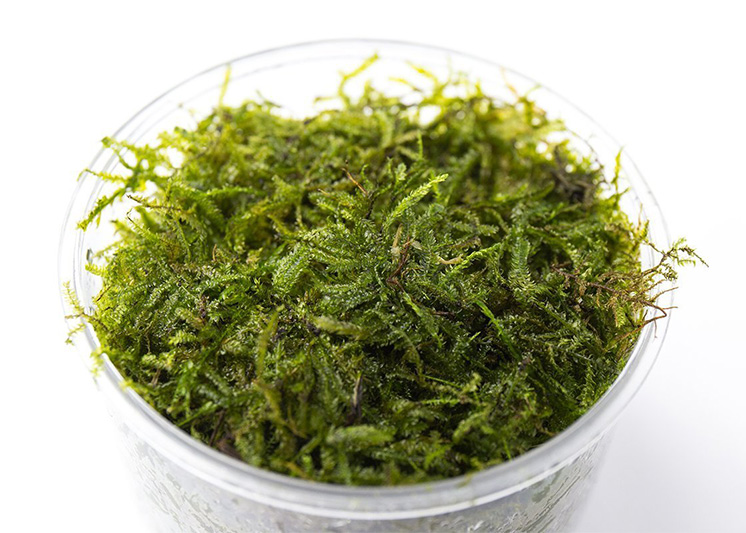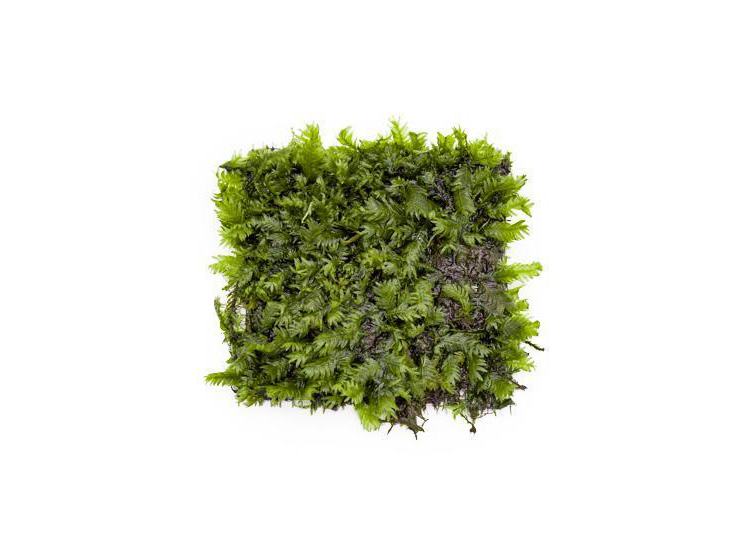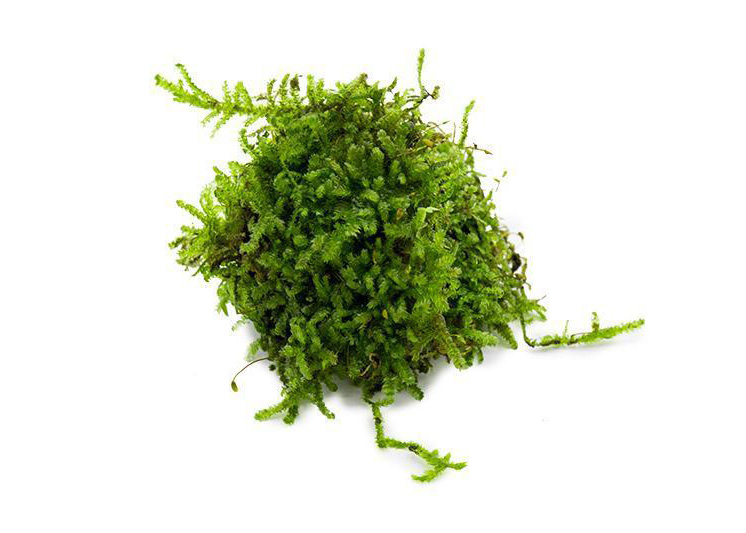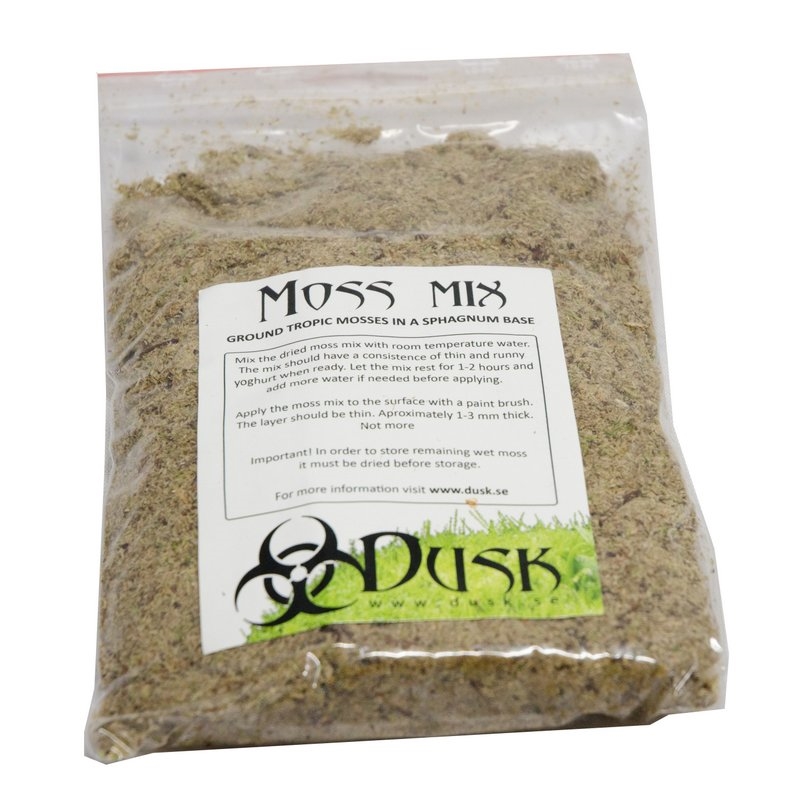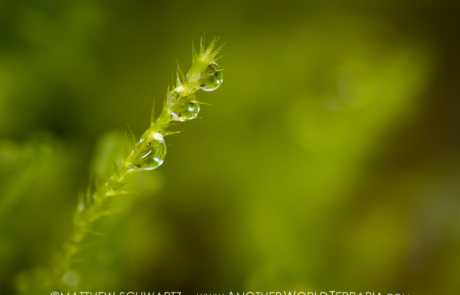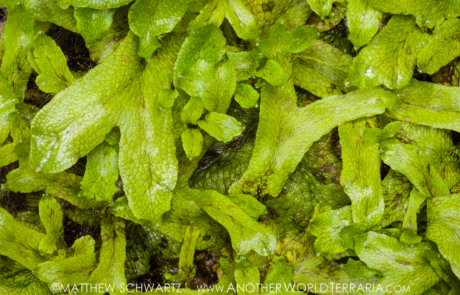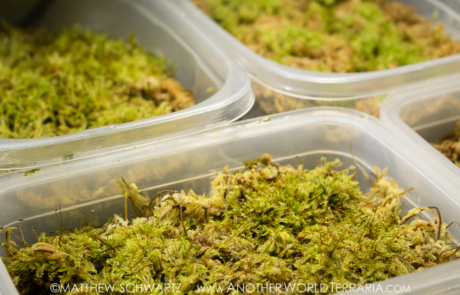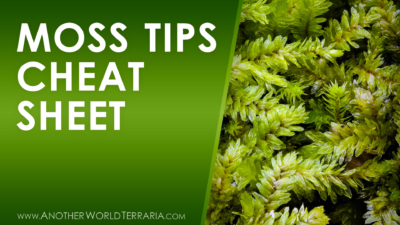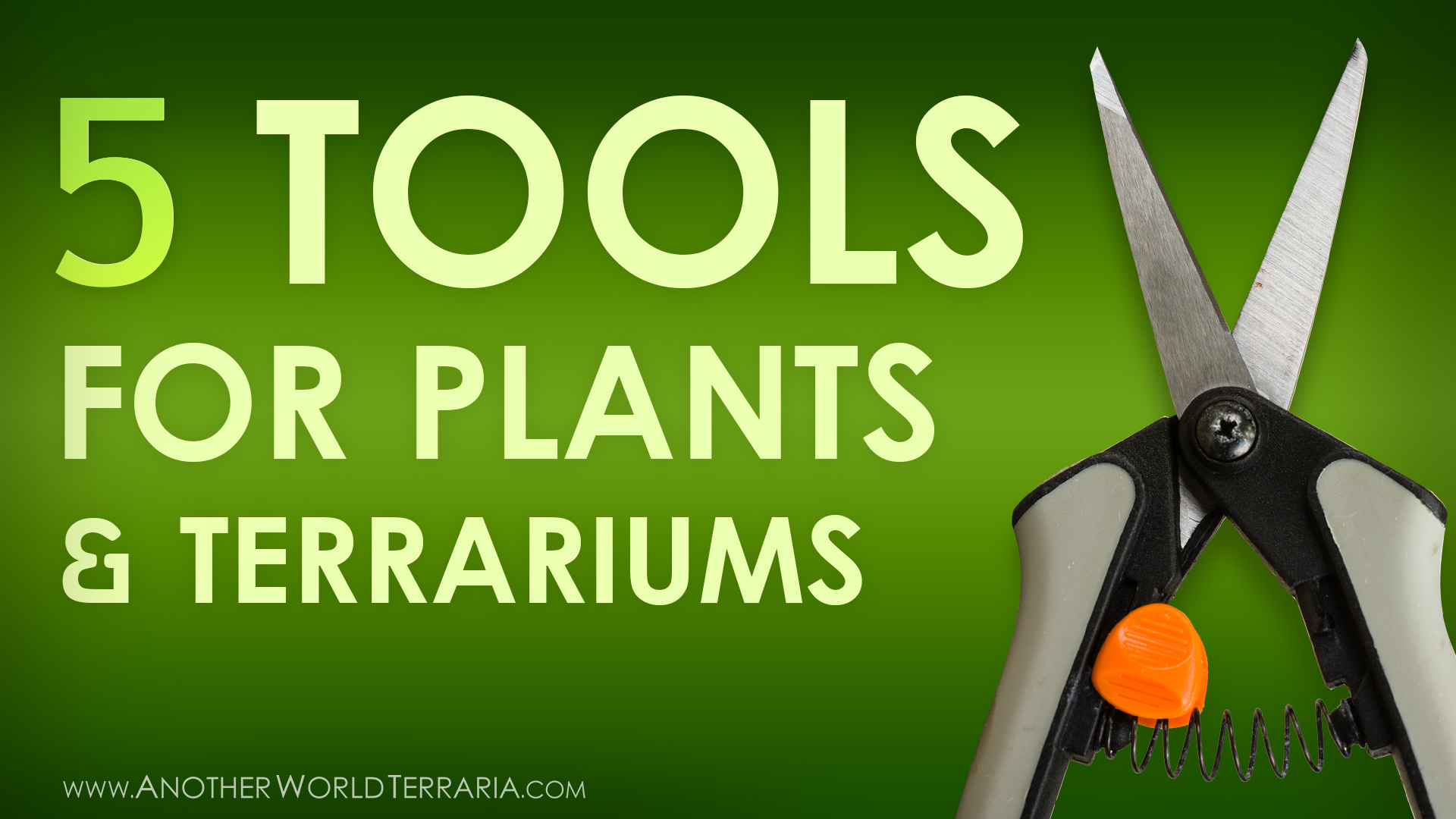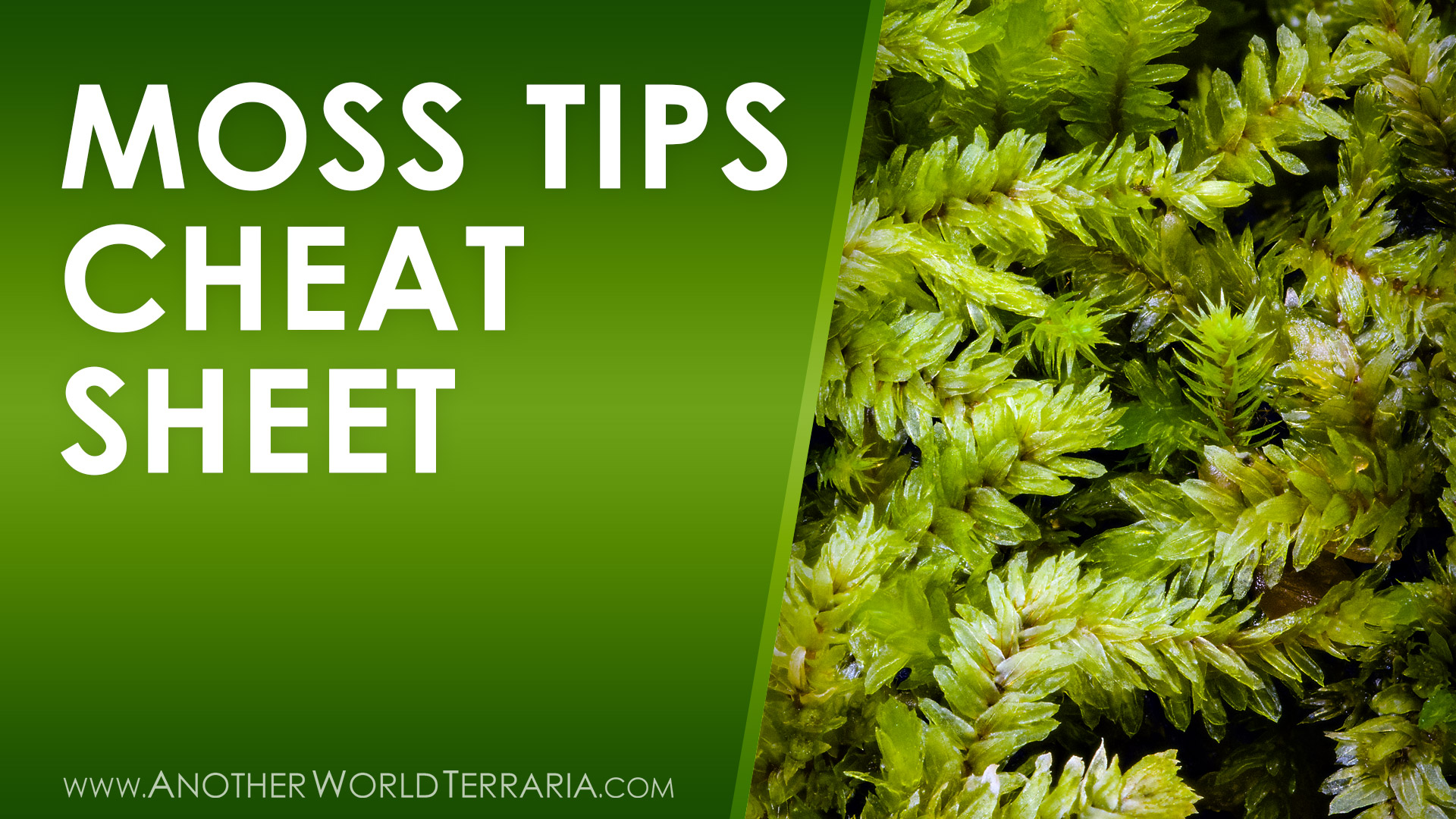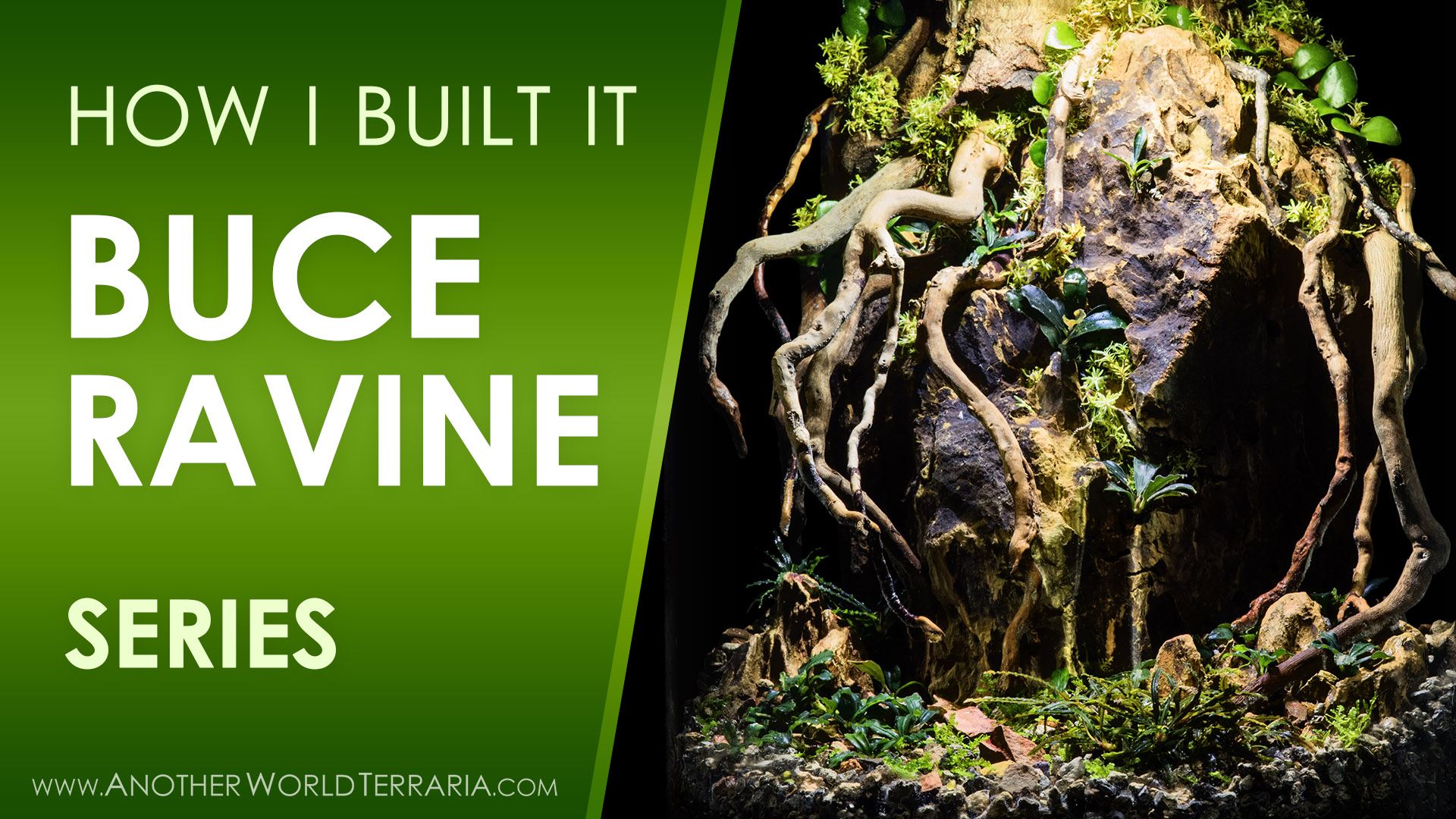This is the ultimate resource about terrarium and vivarium moss and liverworts (collectively, bryophytes).
NOTE: You might also be interested in my Moss Tips Cheat Sheet
In This Article:
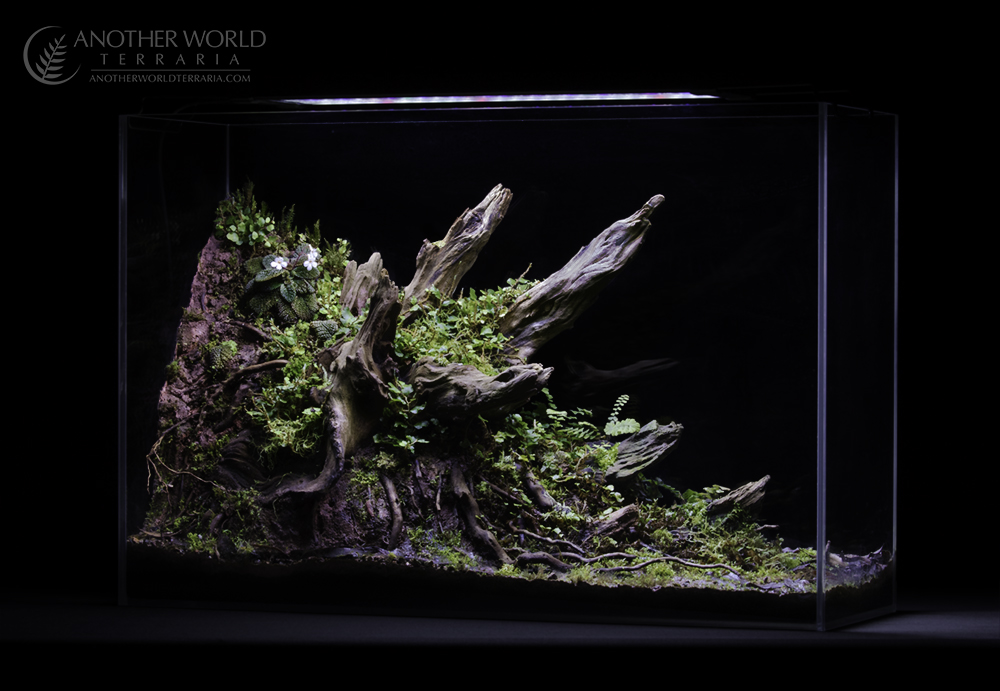
What kind of mosses and liverworts are we interested in?
This article is primarily about tropical and subtropical mosses, liverworts, and hornworts.
They are the species which grow best in tropical terrariums and vivariums. They also look the most natural when combined with tropical plants. That said, a few temperate species have their place, even if only as experiments, and so I’ll briefly mention them in a few sections of this article. Finally, some Bryophyte genera and species are very widespread, even across multiple continents; therefore, they may be considered temperate, subtropical, or tropical, across those geographies, and are adaptable to a wide range of conditions.
One caveat: mosses and liverworts which naturally pop up from substrate, wood, etc, AND which grow well and healthfully (not leggy, not pale, etc) are also considered acceptable, regardless of where (or which climate) they originate from. The key is, do they look how they are supposed to, or are they exhibiting the typical attributes of temperate species in warm, humid conditions (stringy, etiolated, pale, extremely small foliage for the species, etc).
The focus here is also only on live mosses, liverworts, and hornworts
We’re going to avoid dead, dried, and dyed items which are often offered in garden and craft stores. More on that later. Lichen and similar organisms will not be part of the discussion, either. Most lichen species are extremely specialized in their requirements and do not grow well in indoor artificial environments.
In essence, what we’re really interested in is moss and liverwort that will be a natural and integrated part of the living, natural environment within terrariums, vivariums, and plant growing spaces.
By the way, mosses and liverworts (along with hornworts) fall into an informal category known as Bryophytes.
What are the benefits of moss and liverworts?
Most people probably just think of moss as something that’s green and looks nice. However, there are numerous positive aspects of growing moss.
Some less obvious benefits of Bryophytes:
- Help retain moisture in the substrate
- Sustain structural integrity of the substrate to reduce erosion
- Maintain and improve substrate health by utilizing excess nutrients and absorbing unwanted chemicals
- Provide shelter for beneficial microfauna such as isopods and springtails
Most people want Bryophytes because of their visual appeal:
In display tanks

Brancharium
Mosses and liverworts, when grown in a terrarium or vivarium, create an aesthetically pleasing effect. They naturally blend together the hardscapes of wood, rocks, and background, and create a transition from water to land in paludariums and water features. Mosses and liverworts also pair perfectly with other plants. They are beautiful and interesting.
In grow spaces
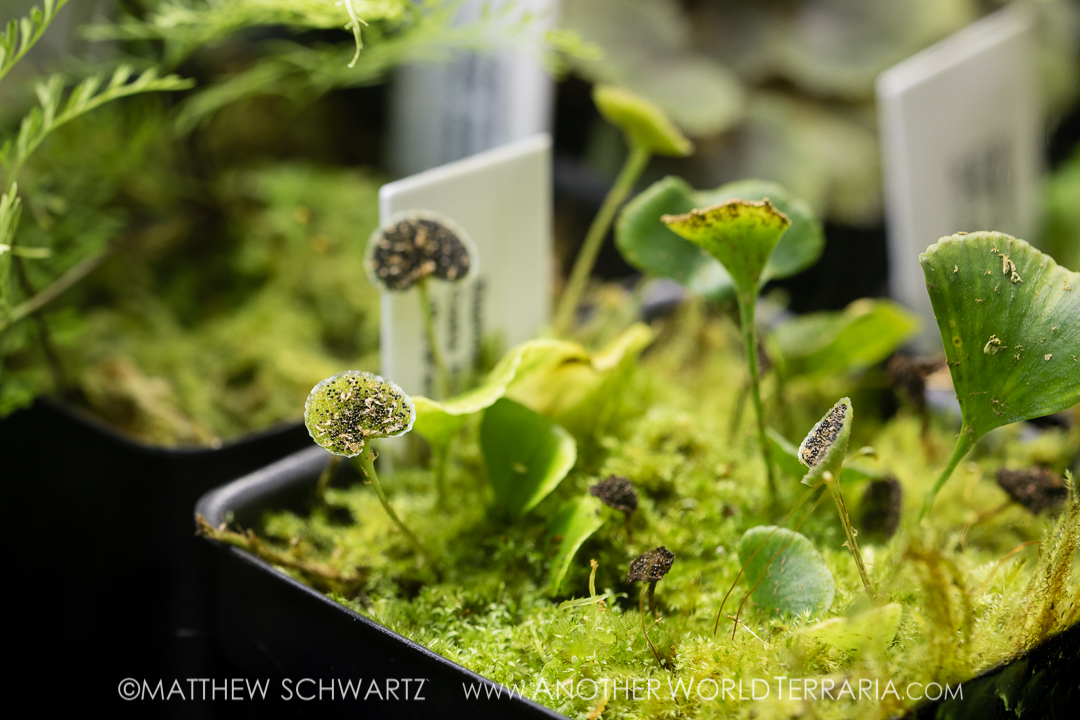
Moss carpet in a pot with Elaphoglossum peltatum fma Standleyi
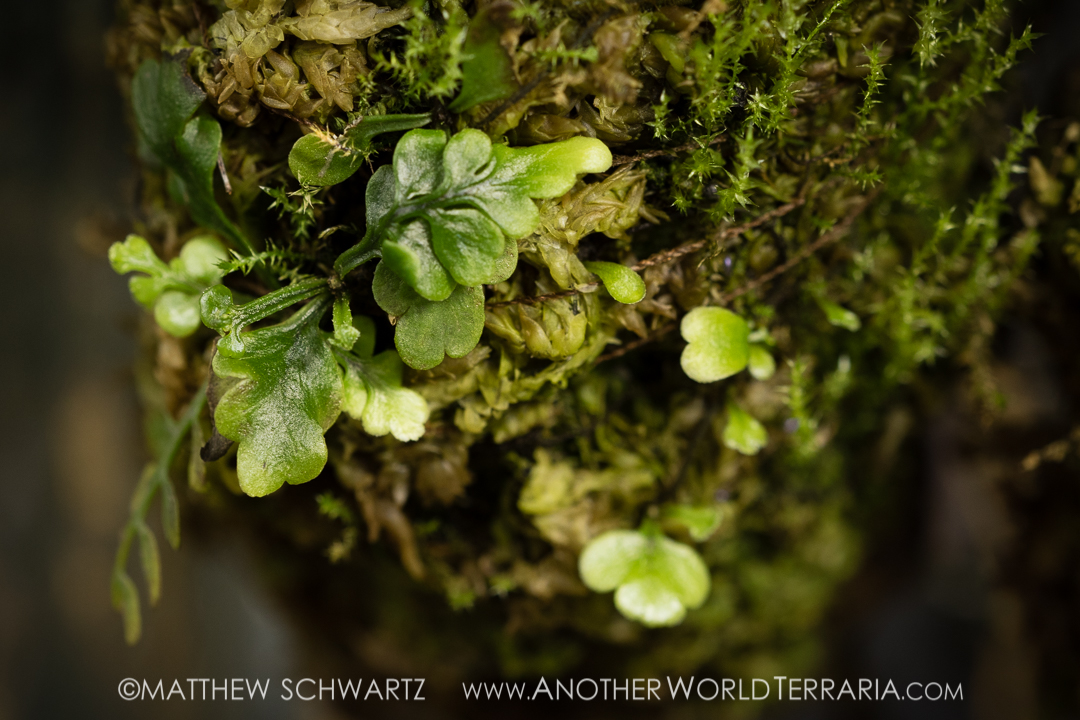
Asplenium sp. on vertical mount with moss
Bryophytes add a layer of nature to grow tanks, which are otherwise sterile and utilitarian setups. They improve these conditions by creating a complementary carpet on substrates, both in terrestrial species’ containers, and epiphytic species’ hanging mounts.
As a hobby and source of enjoyment
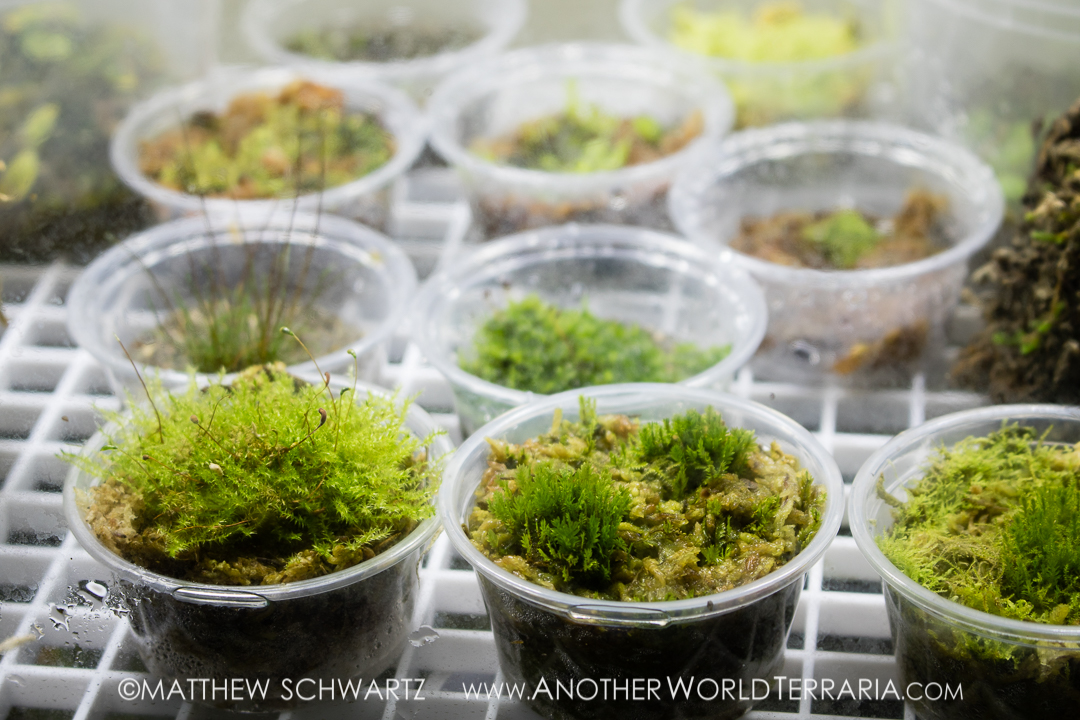
A small collection of mosses and liverworts
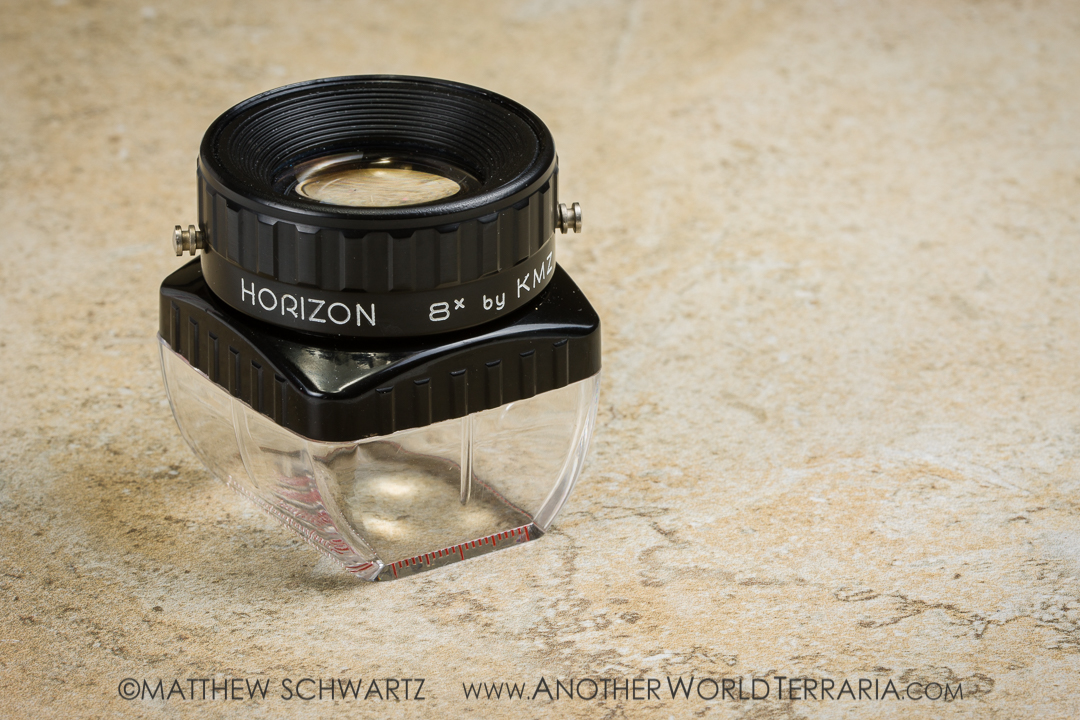
A loupe for examining Bryophytes
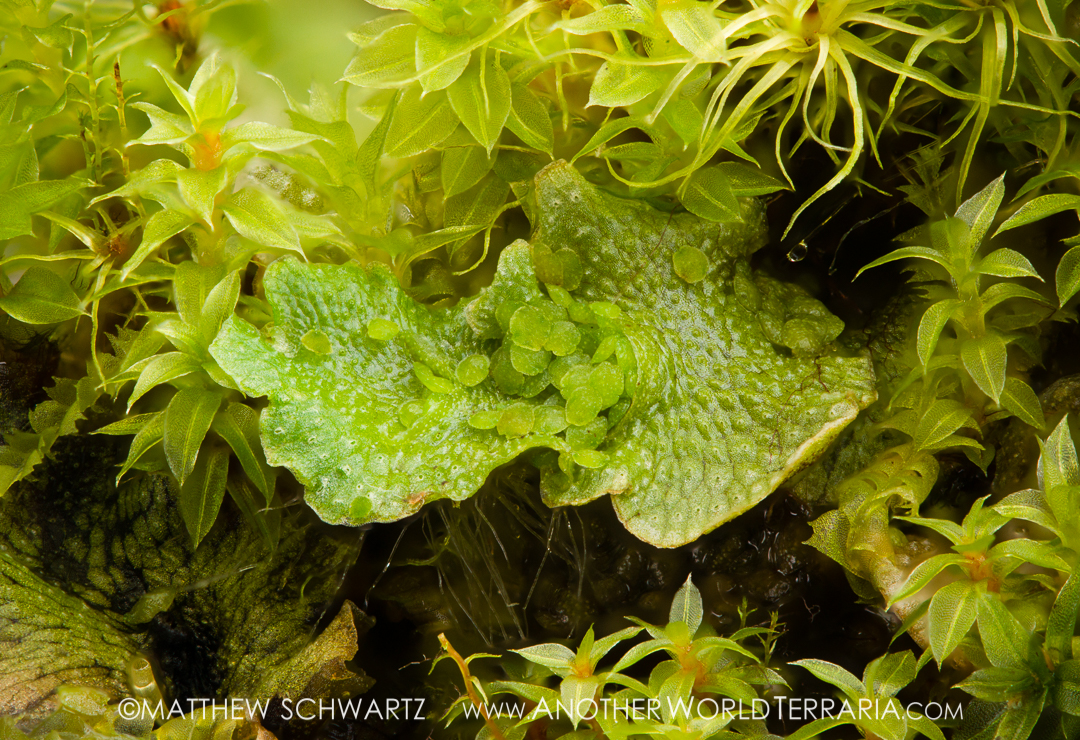
Marchantia polymorpha with gemma
Some people collect and grow mosses and liverworts not just for their overall good looks, but also for the interesting attributes of individual species. Just as someone could have a collection of orchids, or Begonias, another person might collect Bryophytes. Some collectors may be passionate about particular genera, such as Fissidens or Plagiochila.
There are a seemingly endless variety of mosses and liverworts. There are so many different textures, colors, shapes, sizes, and growth patterns, that you could grow just mosses and liverworts, and never be bored.
Although the beauty of mosses and liverworts can be observed with the naked eye, enjoyment can be taken to the next level by using magnifying optics such as a loupe. When you see the forms, details, and colors of moss leaves and liverwort thalli up close, it opens up a new world to explore and admire.
Macro photography can also increase your appreciation for Bryophytes, while allowing you to share it with others.
How to get moss and liverworts for terrariums and vivariums
One of the most important things to know about getting moss and liverworts that are appropriate for tropical terrariums and vivariums is that you will need to be patient.
It can be a challenging and sometimes slow process to increase your moss and liverwort collection, especially if you’re somewhat picky about which species you want. It will take a long time to grow Bryophytes naturally from spore in the environment; you may have to wait months or even years (depending on the species), to get significant growth over large areas.
Grow them naturally
Moss will often grow naturally from spore, rising out of horticultural sphagnum moss, peat moss, soil mixes, hardscape wood, and so on.
In order for this to occur, you will need constantly humid and moist conditions, as well as bright light. You’ll also need patience, as this will often take several months to occur, and even longer for the moss to grow in fully.
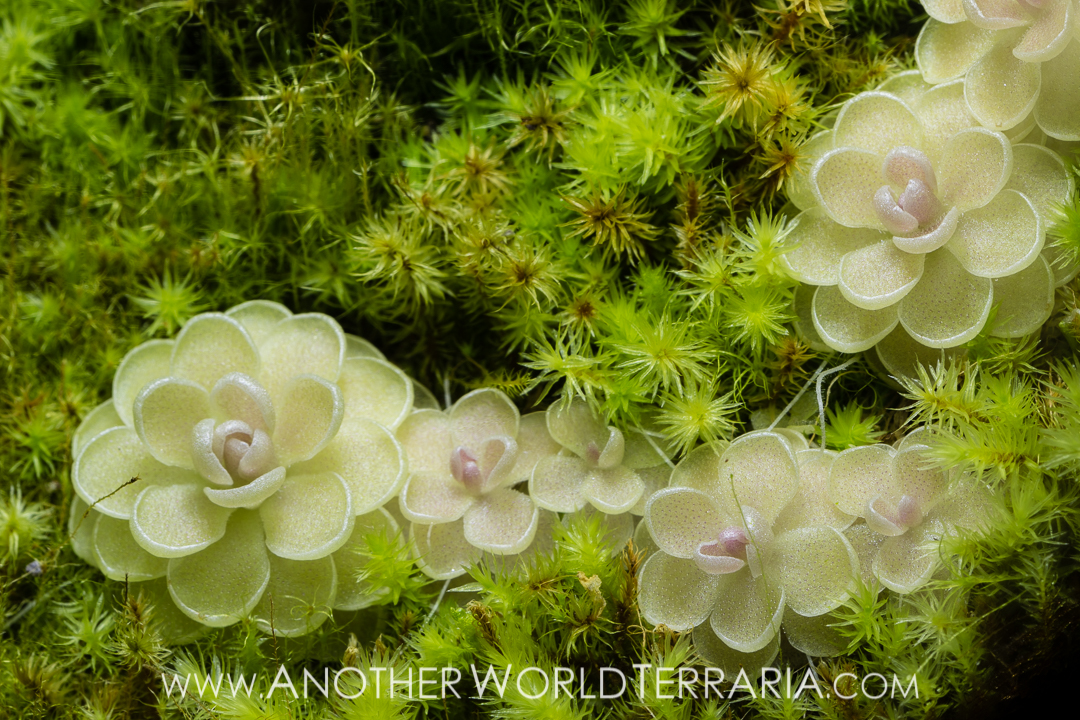
“Ping Jar Closeup”
From hitchhikers on plants
When you buy or import tropical plants, you may get some moss and liverwort species along with them, either as small pieces, mats, or spores.
Purchase from specialty retailers:
Vivarium and aquarium stores and online retailers
Live tropical mosses and liverworts:
These are very rarely available for purchase, but when you’re sure they are a species that are terrarium suitable, get them while you can.
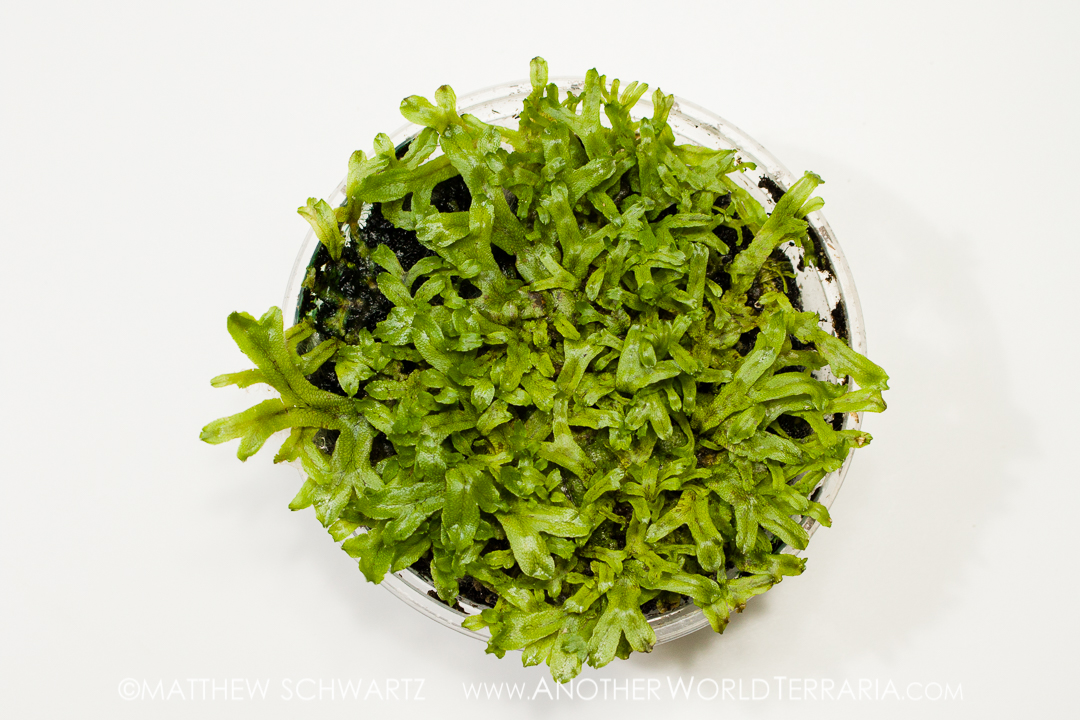
Liverwort (possibly Conocephalum conicum), purchased from a terrarium plant supplier.
Aquatic / amphibious species:
Aquatic mosses and liverworts can obtained from online vendors and sometimes pet stores. Most species can be gradually transitioned to emersed growth, and once adapted, grow well. The transition period can be several weeks to several months or more, depending on the species and the conditions you provide.
For hobbyists in the USA, I use and highly recommend Buceplant.com.They carry a big selection of aquatic mosses (as well as tons of other amphibious and aquatic plants which can be grown emersed for terraria and wabi kusa.)
Here are a few of the most popular aquarium mosses on Buceplant.com (Pearl Moss, Java Moss, Fissidens, and Christmas Moss)
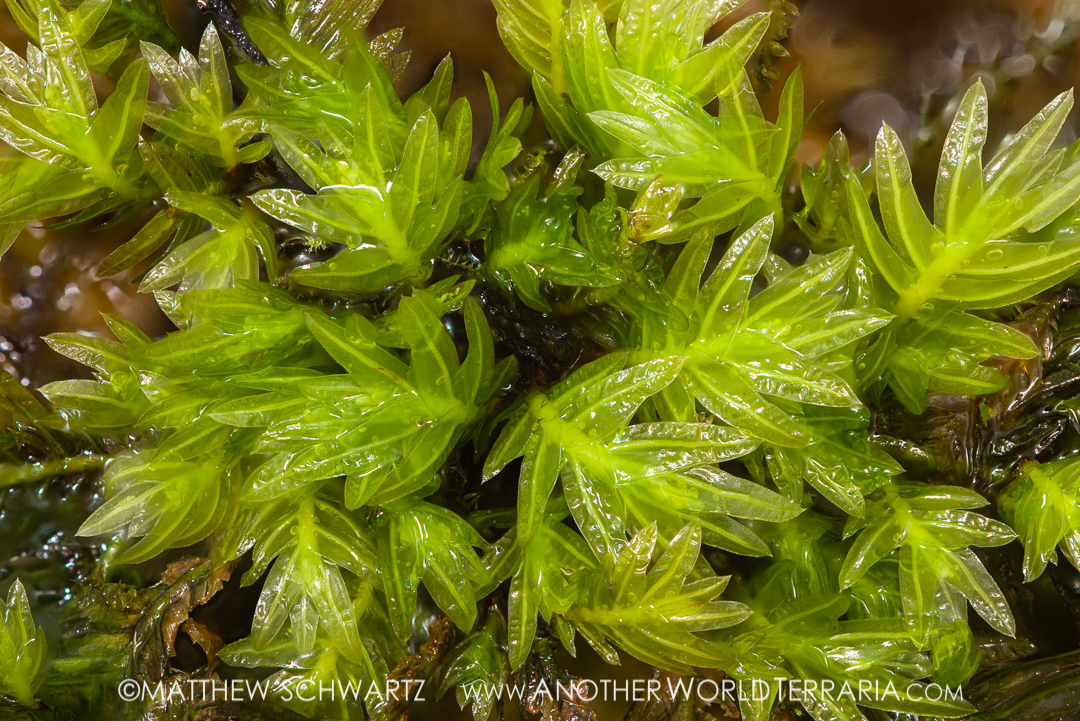
Emersed growth of Fissidens nobilis. Plant was purchased from an aquatic plant supplier and then transitioned to terrestrial growth.
Moss slurries:
Slurries are ground up moss, sometimes with spores, that are mixed into a liquid base, which you can spread onto wet surfaces. These will usually start to grow within several weeks, and will begin to look nice within a few months.
The species in a slurry may vary depending on the source; some will be more suited to tropical conditions than others. The assortment may include large and small species, and those which are fast and slow growing.
Slurries are a good option if you have a large area to cover, don’t want to wait years for moss to grow in naturally, and can’t obtain sufficient quantities of pre-grown moss.
Moss spores and mixes:
Mixes are spores mixed with sphagnum or other substrate, which you moisten and then spread on hardscape surfaces and substrates. They take much more time to get growth than a slurry, since you’ll be waiting for spore germination and the following plant development, as opposed to growth of live moss pieces which begins immediately.
Like the natural methods noted earlier, you will need humid, wet conditions, bright light, and a lot of patience to grow moss from spore.
Dusk Moss Mix
Probably the most well-known product in this category is Dusk Moss Mix, which is named after the Swedish company that produces it, Dusk Tropic (or just Dusk for short). Dusk is also the creator of several other renowned products, including Hygrolon, Epiweb, Synthic, and more.
Although I’ve not used Dusk Moss Mix, there’s plenty of evidence online that proves it’s a great product (to be expected, given the excellence of their other products). You can find photos, videos, and testimonials documenting the appearance, growth, and other attributes of the product.
Based on what I’ve seen and read, the Dusk mix contains larger growing bryophyte species, so it would probably be best suited to medium and large terrariums and vivariums. I would avoid using it in very small or nano tanks because it will quickly outgrow the confines, overrun micro plant species, and ruin the aesthetics and scale of your landscaping.
If you’d like to give it a try, you can get Dusk Moss Mix from Glass Box Tropicals
Buy and trade with hobbyists and collectors
Hobbyists with terrariums, vivariums, and plant collections usually have an exceptional selection of moss and liverwort species growing in their tanks and greenhouses. Although getting moss from hobbyists can result in some real gems, it isn’t always easy.
Sometimes you can purchase or trade for them, or even get some freebies if you ask politely, but get in the habit of expecting very small quantities. Few people have enough tropical moss to offer large carpets.
It’s best to contact the person privately and ask about what they have, and if they can help you out; and it’s even better if it’s someone you already have a friendship with. Be prepared to get turned down quite a bit, but don’t take it personally – remember that Bryophytes are relatively slow growing, are an integral part of the aesthetics of a display tank, and usually garner little attention from most people.

A small trade with various mosses, liverworts, and a bonus cutting of Hydrocotyle tripartita.
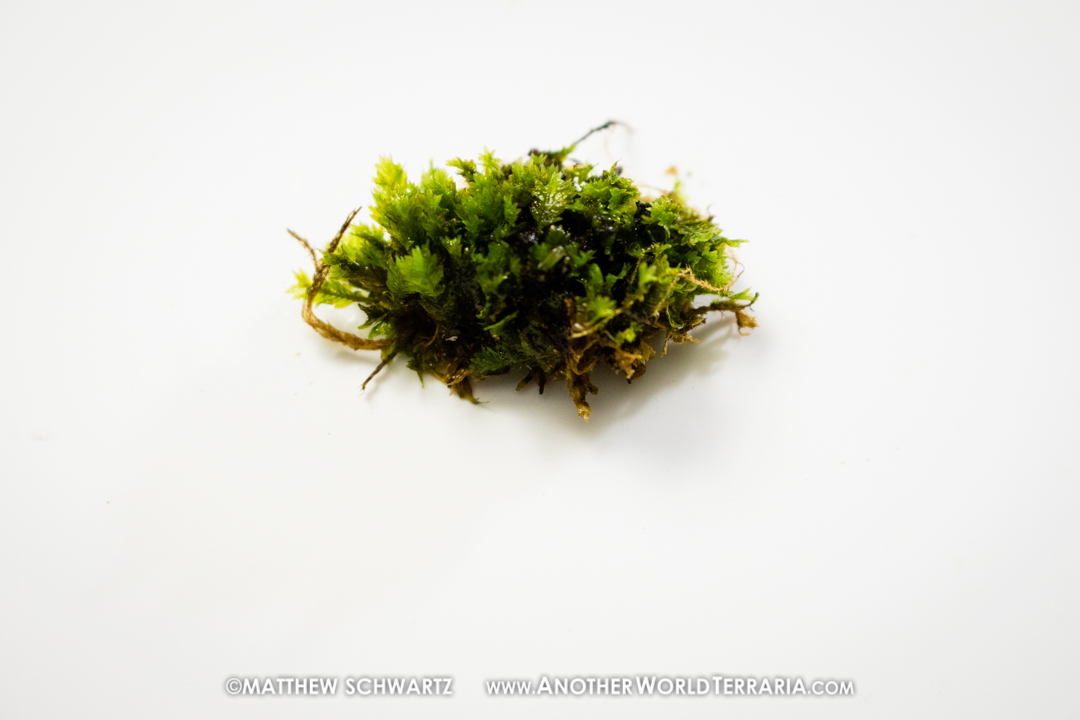
A tiny Fissidens sp. received in a trade
Import moss from other countries
The primary advantage of importing is that you can obtain a greater variety of species than are available in your own country, including rare and unusual specimens.
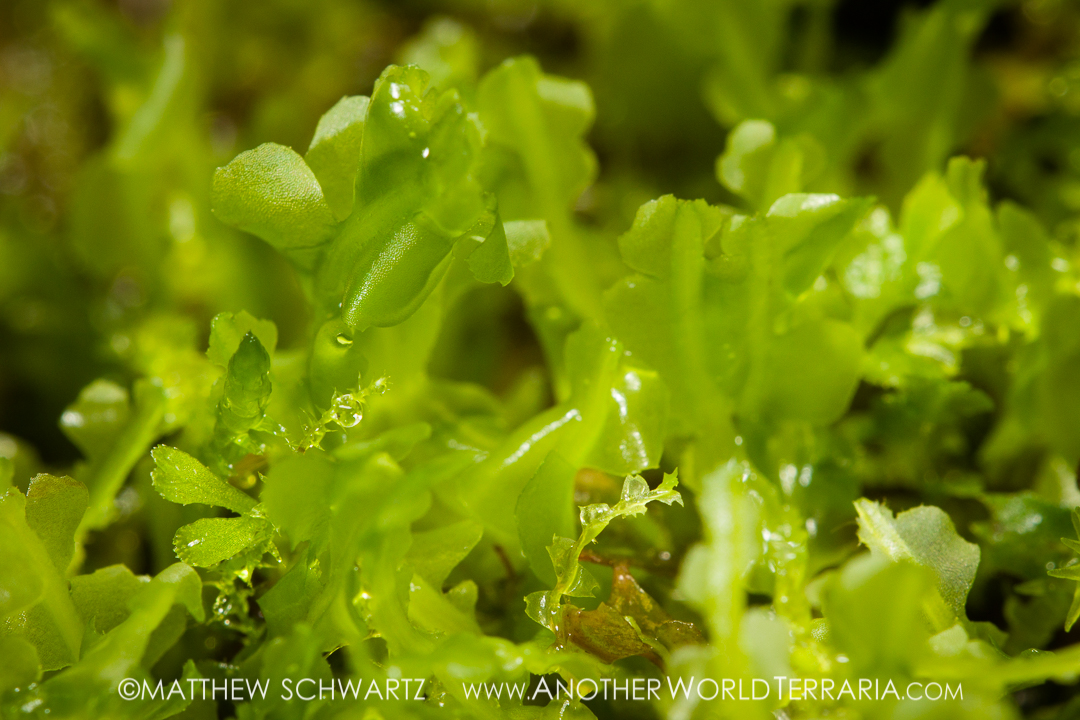
Tropical liverwort sp. from Ecuador
However, the downsides of importing are significant:
- Imported mosses and liverworts are usually wild-collected, which is harmful to the environment.
- They may also contain pests, unwanted invasive plants or seeds, or pathogens such as “Chytrid” fungus (Batrachochytrium dendrobatidis, which is deadly to amphibians), or similar fungus and disease.
- Special permits and certificates may be legally required.
- Shipping costs can be a significant detriment to the often reasonable prices of the plants.
- You should be prepared for the possibility that the plants may come in poor condition, if not dead (especially if the seller is not skilled at properly packing them, or if shipping conditions are not ideal).
Importing should be approached from the perspective of a balance between potential risk and potential reward.
Pro Tip:
Even if some of the imported mosses appear dead, plant them as you normally would, and be very patient. It’s possible for the tiniest piece, invisible to the eye, to still be alive and able to grow, or even for spore to germinate. Within a few months, you may have mosses, liverworts, ferns, or even plant seedlings, despite the seemingly lifeless import.
Collect moss
The most enticing and instantly gratifying method of getting moss also has the most drawbacks.
From tropical greenhouses
If you’re going to collect moss, the most effective and recommended source is a tropical greenhouse. That’s because the species are more adapted to warm and humid conditions, similar to those in a vivarium or tropical terrarium. Also, collecting from a greenhouse, with permission, is legal and is not harmful to the environment, unlike wild-collecting of moss and liverworts in some areas.
Be aware that the same warnings apply to greenhouse-collected species as they do to wild-collected species; they can harbor pests, and may introduce pathogens and fungi which can be harmful or deadly to animals (particularly amphibians).
Be cautious of the possibility that greenhouse-collected moss may contain pesticides, fertilizers, and other chemicals.
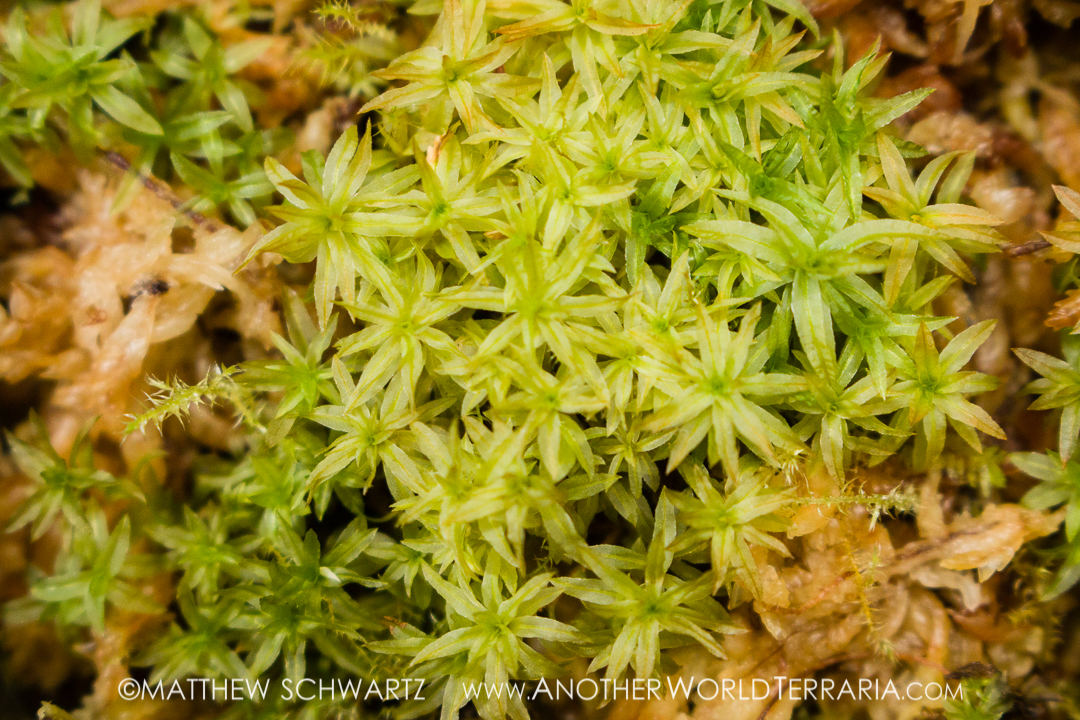
Atrichum sp. collected from a tropical greenhouse
From wild areas
I hesitated when considering if I should include “wild collecting” in this article. The reason why I decided in favor of bringing up this topic is because it gives me the opportunity to educate people on relevant ethical considerations, and bring to their attention some possible consequences of harvesting wild stock. Further, I can suggest ways of going this route which will have the least impact on the environment. I feel that, instead of sweeping controversial ideas under the rug, we should openly discuss them; only by surfacing facts and quality information can we bring about a positive change. Also see the “Critical information about vendors of wild-collected Bryophytes” section of this article for important information.
Collecting moss and liverwort from wild areas may be illegal, and is harmful to the environment. Know and comply with the laws and regulations for the area you would like to collect from. Get permits when necessary. If the collection site is on private property, obtain permission from the owner.
Never collect species which are rare or endangered, are present in small amounts, or are within a fragile environment.
One way to mitigate the harmful effects of collecting wild moss is to find areas which are going to be leveled and developed. If you can get permission from the property owner, you can rescue the moss from destruction, while also getting it for your own use.
Another good option is to collect from your own property. Any land around your place of residence will likely have at least a few species of Bryophytes. Still, collect conservatively, considering what effects you’ll have on the land and wildlife.
Always take extremely small samples; you only need a tiny piece to get started, and if it dies, you’ll have had the smallest negative impact on the environment.
As mentioned earlier, some temperate species can work in tropical terraria, especially liverworts, but are not recommended as much as tropical species.
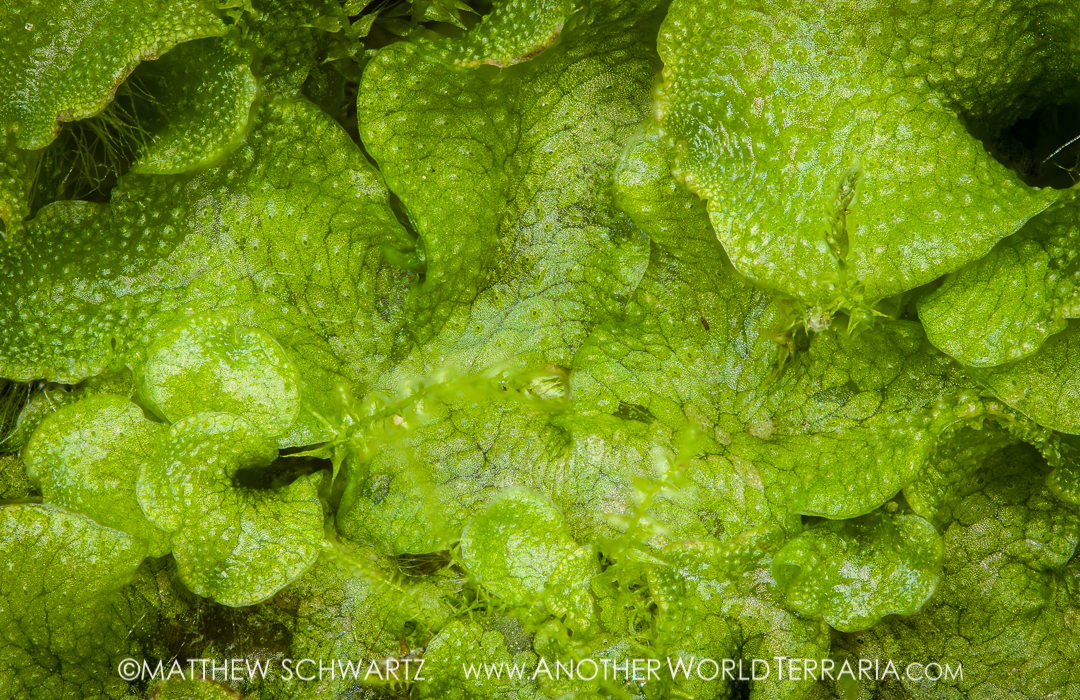
Lunularia sp (elliptical gemma cups not visible)
Important things to know about mosses and liverworts for terrariums and vivariums
Warnings, Cautions, and Advice
If you keep amphibians, be aware of the deadly Chytrid fungus and other risks
This is true regardless of how you obtain them and from where they came from. If you’re getting mosses from people who keep frogs or other amphibians, be especially cautious. You may wish to look for “frog free” moss (and other plants) to reduce the risk of Chytrid or diseases being passed between captive animals, though you cannot entirely eliminate the danger. Wild-collected mosses, greenhouse mosses, and any other mosses carry the same risks.
AVOID most mosses that are found online through searches for “terrarium moss”
Counter-intuitively, about 95% of mosses that you find by searching for “terrarium moss” will not be suitable and will not grow optimally, or even at all. Many are species which do not usually do well in terrarium conditions, and some are not even alive. Beware of “sheet moss,” “pillow moss,” “mood moss,” lichen, reindeer moss (a type of lichen, not a moss), and so on.
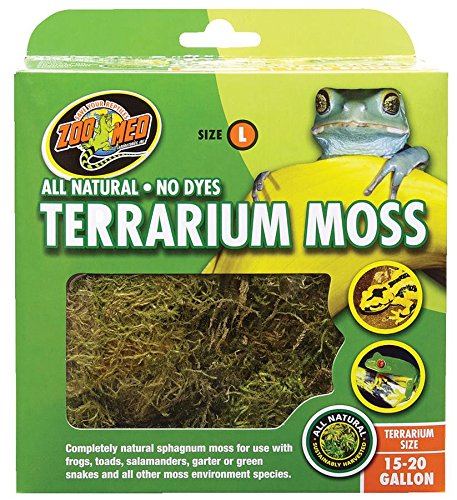
Within the context of this article, this is not a good terrarium moss.
AVOID all mosses and liverworts that are sold for craft and hobby purposes
They are usually dead, dried, and sometimes dyed. They will simply fade, decompose, grow mold, and may release harmful chemicals such as dyes or preservatives into the terrarium or grow tank.
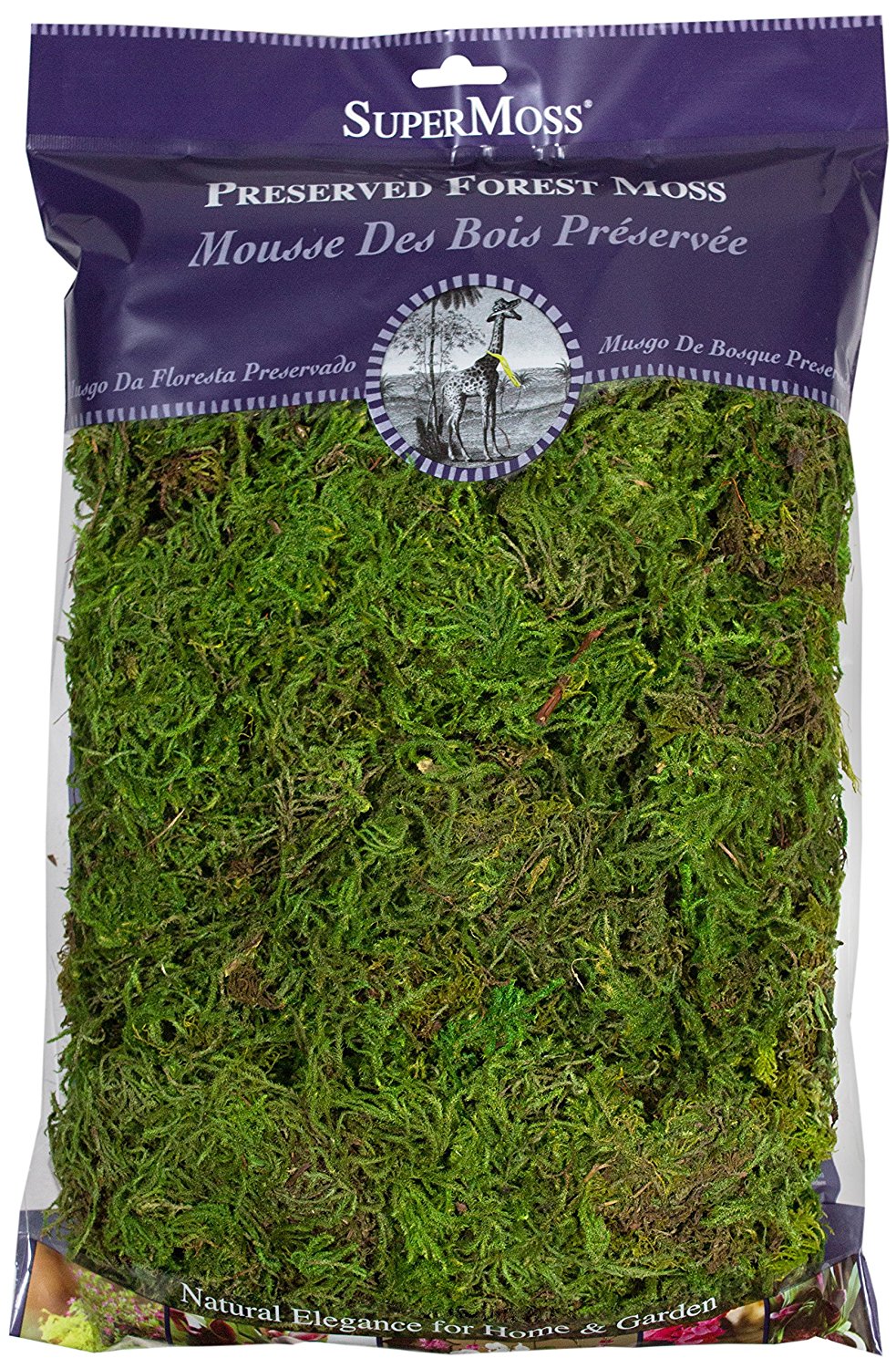
Dried and dyed – not for living terraria ecosystems!
AVOID most species from temperate regions
Most temperate mosses do not fare well in tropical terrarium conditions. Notice that I said “most species,” not “all species.” Some temperate mosses do OK in those conditions, particularly those with widespread ranges that may cross into warmer locales. Liverworts, in general, are more adaptable than mosses, and many temperate species will grow very well in terrariums, given proper conditions. However, see cautions below regarding wild-collected items.
AVOID most Bryophytes that are wild collected
This is especially critical if you have a vivarium with frogs or other amphibians, as wild-collected plants may introduce Chytrid, or similar fungus and disease. Wild-collected Bryophytes will also often harbor pests. It is possible to have a laboratory test done to check for Chytrid, and it’s also possible to quarantine and watch for pests, but still there is always a risk involved.
Aside from the potential negative effects of introducing wild-collected items into your tanks, you have to also consider the damage that is done to the ecosystem from which they are taken. There are rare exceptions in which the negative effects of harvesting wild bryophytes can be mitigated or even eliminated. (See other section in this article about wild collected Bryophytes)
AVOID growing large and aggressive species (in most cases…)
This advice applies to the following situations:
- When you’re growing miniature or micro plants, (1) because they are easily smothered and killed by fast-growing and robust Bryophytes, and (2) because the size of the moss will not look aesthetically appropriate in comparison to the size of the plants (this relates to an artistic term called “scale”).
- When you’re growing certain orchids and finicky plants which need air flow to their roots or foliage to avoid rot
- When the growing container is small in size, (1) because the aggressive and large species will overtake the container too fast, and (2) because of scale (see the first point in this section)
- When you want a more refined and controllable appearance to a display tank. This is especially true if you prefer to keep the hardscape visible, and like a more compact carpeting effect as opposed to a wild, bushy look.
Critical information about vendors of wild-collected Bryophytes (and other plants and products)
In many cases (probably the majority), harvesting of Bryophytes is done illegally and unsustainably, without regard to detrimental impacts on the species’ populations and habitats. This will negatively affect the other plants, animals, and ecosystem in which the mosses and liverworts were growing.
Wild harvesting also hurts other people who would otherwise have enjoyed seeing a beautiful, natural area. It’s not fun going to a forest and seeing giant blank spots where moss was obviously stripped from trees, rocks, and soil. Unfortunately it’s a common and widespread practice.
Some legitimate businesses that collect wild bryophytes have obtained permits to legally do so, and their harvesting methods are done responsibly and sustainably. Some of them also participate in “rescuing” these plants from areas which are slated to be destroyed and developed.
Before buying Bryophytes online from a vendor:
I recommend that you contact the vendor and ask if they have the appropriate legal permits to do wild collecting, or if their distributor or source has those permits. You can ask to see a copy of that paperwork to confirm that they’re telling the truth. By refusing to purchase from companies who are unethically obtaining Bryophytes and plants, you can play a part in helping the environment, and in supporting the companies that are doing things the right way.
Quick tips and things to know about moss and liverworts
Most mosses and liverworts need brighter light than many people are led to believe.
Not all Bryophytes are shade lovers. Even more importantly, not all “shade” is as dark as people imagine. There are dramatically varying levels of shade, from “deep shade” to “indirect light.” The amount of light needed will depend on the species, and other conditions in your growing container. That said, lighting is beyond the scope of this article.
Not all Bryophytes grow well in the same conditions.
They may require different substrates, pH, lighting, moisture, humidity, air flow, and so on. One of the pieces of advice that I give in my free “30 Tips for Terrarium plants” is to “Know the plant.” That applies to Bryophytes just as much as other plants. When you understand the plant, its growth patterns, its natural habitat, and so forth, you can make informed decisions about the conditions in which to grow it.
Mosses and liverworts will often show up as groups of multiple species.
Especially in small, nano tanks, or around miniature and micro plants, it is recommended that you cull large and aggressive moss species, and keep fine and compact species. The desirable species will not overtake your tiny plants, and will look more aesthetically pleasing due to having the correct size scale in relation to those plants’ stature.
Notes on disinfecting Bryophytes
There isn’t a guaranteed method for completely disinfecting mosses and liverworts (usually with the intent of killing Chytrid and pests), without killing them in the proces. 10% bleach dips are common for disinfecting plants, but most Bryophytes will not survive the treatment, probably due to their Poikilohydric physiologies which result in the bleach being easily absorbed, and because they have soft and thin tissue with little to no protective structures.
Carbon Dioxide fumigation may kill some insects, but isn’t 100% effective, particularly on insect eggs, and smaller insects which can survive in crevices with small pockets of Oxygen. CO2 will not be effective at killing Chytrid.
Desiccation (drying the plants out completely) will also kill some insects (not all), but may result in the death of some Bryophytes, and also in mold growth due the the dried tissue that has died, providing a food source for fungi.
It’s advisable, at a minimum, to thoroughly clean and then quarantine wild-collected mosses and liverworts. Soak them in distilled water and then remove as much substrate as possible. Split open thick cushions to remove larger pests with tweezers. Then rinse thoroughly with distilled water. Finally, put them in a separate quarantine tank for at least 3 months and check every few days for pests. Again, note that washing and quarantining will not have any effect on Chytrid.
Recap
Mosses and liverworts are excellent for adding natural beauty and interest to terraria and horticultural substrates.
There are many to choose from; you can collect different species to your heart’s content.
It’s best to use tropical species because they are adapted to terrarium conditions.
If you keep amphibians, be aware that mosses and liverworts may contain deadly Chytrid fungus and other pathogens, as well as pests.
There are many different ways to obtain moss and liverworts for terraria and plant culture, however some ways are better than others.
You should weigh the pros and cons of all of the methods, consider the risks involved, then choose which of them you want to try.
With patience, care, and effort, you will gradually build up a beautiful collection of interesting moss and liverwort species which will fill out your terraria and grow tank substrates.

